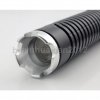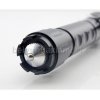
Hey guys! This may be a very vague question, but there's only a few things about the flow of power through a mechanical mod that I'm foggy on.
-I know positive connection is actually where the power connects to the topper.
-That the whole body of the mechanical is actually part of the circuit? (right?)
-That when you fire the button, that allows the current to start actually flowing to the topper? (So is the act of contacting with the negative side of battery, actually grounding the battery? This is the part I'm most fuzzy about, does the negative current run up through the mechanical mod body, and meet with the positive pin? Any explanation of the moment of firing action, would be oh-so-appreciated.)
-The part I understand almost completely is the physics of metals & conductivity, silver & copper are the best, magnets eliminate the volt drop of springs, a larger surface area between the connections and the battery is better, less threading is better (seemless tubes).
***This is just to give you an idea that I have a basic understanding of electricity, and "physics" lol, I don't necessarily need everything spelled out. The one thing I'm having trouble grasping is how the mechanic mod's body is actually part of the circuit, that actual connection of positive to negative with the firing buttond. My brain is telling me that when you fire, the negative side has to go through the metal of the tubing and caps, and then join with the actual positive side of the battery to start flowing, is this right? So would this mean the more conductive metal you have would be a good thing? Or would a thicker tube just "get in the way". I want to say more metal is better for volt drop, (as long as it's above 50% would be a good thing, because it would be more to conduct, and if it's less like stainless or brass even, then the less metal would be good, because it less to "get in the way" of conduction.) but I could be wrong.
I probably am wrong
Thank ya so so so much if you have any input whatsoever, I'm tired of giving an arm and a leg for a mechanical that I really want, so I bought a nicely priced metal lathe off of craigslist, and plan to start making my own vapequipment!
Vape on!



 That's why you attach the negative end of your multimeter to the threading, stupid brain! Sometimes the obvious is the hardest to see in my case :lol)
That's why you attach the negative end of your multimeter to the threading, stupid brain! Sometimes the obvious is the hardest to see in my case :lol)

